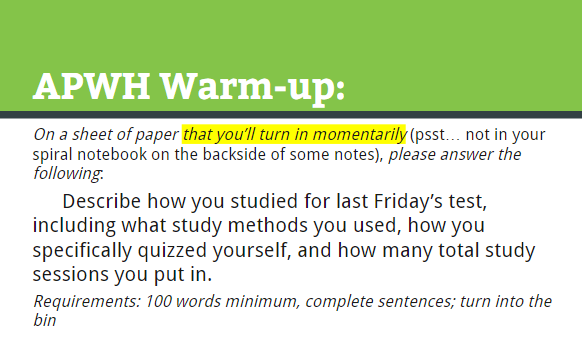Self-regulated learning has been described several ways [1], but the gist of the concept is that self-regulated learners are conscious and in charge of their learning. They analyze a task, set a goal for it, make a plan for achieving the goal, implement the plan, and then self-critique after receiving feedback. Importantly, these different modes are only weakly distinct in the self-regulated learner’s mind, and as self-regulation strengthens, the different modes become decreasingly conscious. In short, those kids in our classes who just seem to “get” how to learn and succeed are advanced self-regulated learners. It's worth noting, too, that self-regulation is distinct from being smart.
It goes without saying that, as we teach through a unit, we teach kids the learning strategies most likely to lead to their success. This becomes easier and easier as we make a practice of studying the differences between students who succeed at a given task and students who do not. When we step away from a “Well, the kid just has a bad home life” or “The kid is just not motivated” stance and step toward a “What can I learn here about successful learning?” mentality, we begin to piece together the moves that matter most in succeeding on a given task. And so, we teach the moves [2].
A simple activity for encouraging (and formatively assessing) self-regulated learning
A little bit ago, my ninth grade AP World History students took their first unit test. The day after the test, after their grades had been posted on PowerSchool, I gave them the following as a warm-up prompt:

Following the writing warm-up, teachers can conduct a quick Pair-Share if they’d like, but the real value (for the kids) is in the five minutes of self-critique the prompt leads them to do, and the real value (for the teacher) is in reading the responses later on to determine
- what commonalities exist amongst students who did well on the test, and
- to what degree students are demonstrating self-regulated learning.
It really is fascinating to start to see the difference between kids with lower self-regulation —
“I mainly studied when I had time, reading bolded/key words in the book. I didn't use my notes at all, and I feel I should have based on my disappointing grade. … Total study sessions for this test probably three, not as much as I should.”
— versus kids with higher self-regulation —
“To study for the test, I went to the class website and collected all of the RPs [Retrieval Practices] we had done so far. I copied and pasted them into a document, removed the answers, and then quizzed myself on which ones I knew. I had 3 study sessions over the week where I did this, retaking the RPs each time to see if I could get a better ‘grade.' Anytime I would get an RP wrong, I'd look in my notes where and when the RP was mentioned, and then read over that section.”
— and to start to find trends in the techniques that did or did not correlate to strong test performance. For example, I noticed that, true to Make It Stick, one technique that didn't seem to work was re-reading (or “going over”) the notes, whereas one technique that did seem to work was a systematic approach to quizzing oneself.
Two birds with one stone
The nice thing with this activity is that it encourages self-regulated learning in our kids, and it gives us information about where our learners are and what the most successful ones are doing. In other words, I'm not working quite as hard, and the kids and I are learning more. That's what's up.
Footnotes:
- For the most concise treatment, see p. 40 of Farrington et al’s Teaching Adolescents to Become Learners.
- Perhaps the best text on learning strategies is Make It Stick, which I’ve referenced before in relation to Doug Stark's Mechanics Instruction that Sticks warm-ups. For an article-length version of much of the book’s content, see Erica Beaton's post here.
NewAgeTeacher says
Wow, what an easy and practical way to help them. Will introduce this to my students and see how it goes. Good post.
davestuartjr says
Thank you! I’m so glad it helped.